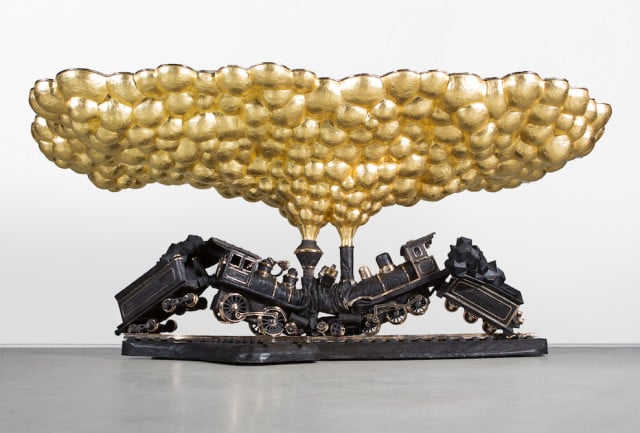
THE DAILY PIC (#1520): This train-crash coffee-table (the flat top of the smoke is where you put your drinks) is one of the centerpieces of the new survey of the Antwerp design atelier called Studio Job, now featured in a big way at the Museum of Arts and Design in New York. I published a whole page on Job in yesterday’s New York Times, but I wonder if I got across just how much the studio’s work would be hated by any design lover with a shred of good taste. I myself can’t imagine that there are many of their pieces that I’d ever want to have in my living room.
But that simply shows that Studio Job is at last helping design catch up with fine art, where for many decades now the most important pieces have been totally unsuited to home use. Who can imagine having an Anri Sala video projection or Jeff Koons porn painting over the sofa? And yet a certain aggressive tastefulness is still the main criterion for “good” design, as it has almost always been. Compared with the cast-bronze pieces by Studio Job, even the most kitsch-aspiring works of 1980s postmodern design still seem built on a scaffolding of modernist elegance.
The truth is, the whole issue of domestic taste is pretty much irrelevant to understanding Studio Job, since its pieces aren’t really design objects at all, so much as pictures of imaginary design objects that happen to executed in 3D, at a scale of one-to-one to the imagined chairs, tables or dressers that they represent. “If we show a bucket, it’s an image of a bucket,” said Nynke Tynagel, who founded the studio alongside Job Smeets.
After spending a few hours with her and Smeets, and studying a vast pile of Job clippings and videos, I think something similar could be said about the two designers: They are all about crafted images – of themselves. Photos have shown them standing at attention in tailored black suits and waltzing barefoot in slinky white; they’ve appeared as workers in paint-slathered coveralls and as farmer’s with apple-red cheeks. (In a pair of goofy portraits on the surface of Job-designed porcelain cups.) When I met him at MAD, Smeets looked as though he was trying on a new persona as a hard-rock roadie from the 1970s. Inhabiting roles, the pair agree, is central to what their art and career are about, the way it was for Warhol and Dali and maybe even for Picasso and Bourgeois.
When the duo founded a display space called “Studio Job Gallery” in Antwerp, it was much more about “playing gallery,” as Smeets put it to me, than attracting collectors or having exhibitions or going to art fairs. Their “Studio Job Suite” in Amsterdam was never supposed to be a real apartment for them to live in so much as an image of an “apartment” that would come to life in magazine photos, and the new Job brewery they are working on now seems more about trying on a brewer’s rubber boots than turning out beer. (Beer will be brewed, they say, but they have no particular opinion about what it ought to taste like.)
I have a feeling that their role as “designers” is just as much part of the necessary artifice that shapes the meaning of their work as it is a natural product of their object making, or a precondition for it. They only need to take their place in the world of design in order for their work to fully register as the antithesis of design’s exhausted standards of good taste.
Because if Tynagel and Smeets simply got counted as “artists”, their works would then have to be “sculptures”, and not much more extreme, even in their bad taste, than many others that are out there in the art world. (Photo by Adrien Millot, courtesy Carpenters Workshop Gallery)
For a full survey of past Daily Pics visit blakegopnik.com/archive.